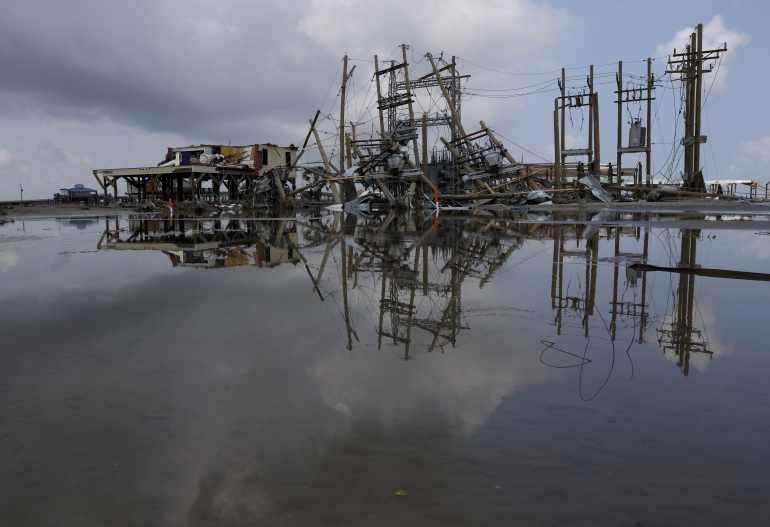Oil continued to climb on Monday with global benchmark Brent nearing $80 a barrel, its highest price since October 2018, as tight supply fuels a crude rally and demand in some parts of the world recovers faster than even the most bullish analysts could have predicted.
Brent crude was up 1.73 percent to $79.44 a barrel by 4:06pm ET (20:06 GMT), having posted three straight weeks of gains. United States benchmark West Texas Intermediate futures gained 2.04 percent to $75.49 a barrel, the highest since July.
The current rally has caused Goldman Sachs analysts to boost the bank’s year-end forecast for Brent from $80 to $90 per barrel. In a note to investors on Monday, Goldman said the current global oil supply-demand deficit is larger than it had initially expected.
“I think the drama that we’re currently seeing in the market is a collision of three massive forces,” Deputy Director of the Atlantic Council’s Global Energy Center Reed Blakemore told Al Jazeera.
“The impact of prolonged demand uncertainty due to COVID-19 on supply-side management over the past year; the structural changes of a policy-driven transition to a net-zero world; and the reality that sufficient investment and development of oil and gas supplies is still crucial to market stability even amidst a global energy transition,” he said.
Oil prices collapsed in April 2020 as the coronavirus pandemic halted global economic activity and decimated demand for crude. But the rollback of pandemic restrictions this year, along with business reopenings and climbing vaccination rates, has spawned a recovery in global crude demand.
The economic recovery, however, is not the only reason for the current crude rally.
Last month, Hurricane Ida-related outages badly hit supply in the US and offset the ramp-up in OPEC+ production that the bloc’s members agreed to increase last July.
The Organization of the Petroleum Exporting Countries and its allies, a grouping known as OPEC+ and led by Russia and Saudi Arabia, had tightened supply when the pandemic first hit and prices plummeted. Having lifted those prices out of the abyss, they agreed to slowly loosen the taps and allow more barrels to hit the global market. The cartel is set to meet on October 4, and on Tuesday OPEC releases its snapshot of where markets are headed with its World Oil Outlook.
According to the International Energy Agency (IEA), the world consumed 99.7 million barrels per day (bpd) of oil in 2019, before the COVID-19 pandemic collapsed fuel demand. As the global economy recovers, the IEA predicts that crude demand will return to pre-pandemic levels sometime next year.
“We’re likely to see immediate price growth continue as a follow-on to the ongoing natural gas supply crunch in European markets and the slower-than-hoped reintroduction of US production affected by Hurricane Ida,” Blakemore told Al Jazeera.
“Even with OPEC expected to loosen supply restrictions by another 400,000 barrels next week, it’s quite possible that we’re only seeing the beginning of a more significant price rally over the next few weeks/month as concerns about the global supply picture come more sharply into focus,” he said. “If we end up with a cold winter, things could definitely get worse.”
The bulls and the bears
“What could go wrong” is a question Goldman Sachs analysts pondered in their investor note. They did not rule out a fresh coronavirus variant rendering vaccines ineffective and ultimately derailing the economic recovery.
But bar that, Goldman says the bull run fuelled by the oil-supply deficit is here to stay, at least for a while.
OPEC+ deciding “to an aggressively faster ramp-up in production by year-end would soften (but not derail) our projected deficit, it would only further delay the shale rebound,” Goldman analysts said.
The move, they noted, would reinforce the structural nature of the next rally given binding underinvestment in oil services by 2023.
“In addition, a large ramp-up in OPEC+ production would simply fast-forward the decline in global spare capacity to historically low levels, replacing a cyclical tight market with a structural one,” Goldman said.
But there are still short-term risks to the rally on the horizon, some analysts say.
“The rally could be extinguished either as investors opt for profit taking or in the longer term, as a lethargic economic recovery brings commodity prices back down to a more humble perch,” Rystad Energy’s Senior Oil Markets Analyst Louise Dickson said in a note on Monday.
But again, there are always weather and natural disaster events beyond anyone’s control.
“Hurricane Sam, though currently forecasted to be less intense than previous storms this season, could … add to the energy crisis fears that lift up not only oil and gas futures, but propane, gasoil, and fuel oil,” Dickson added.
Russia could cause prices to cool by boosting production. Kazakhstan is upping production after reopening one of its refineries. And analysts will watch China this week, as its current power shortages could cause output to fall.

